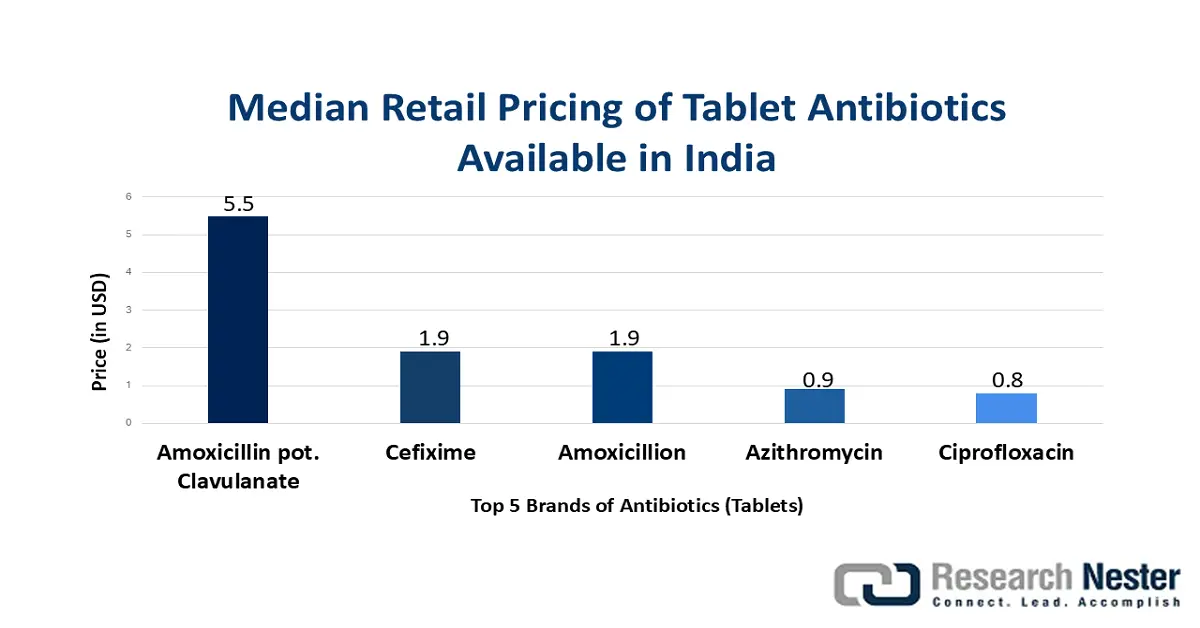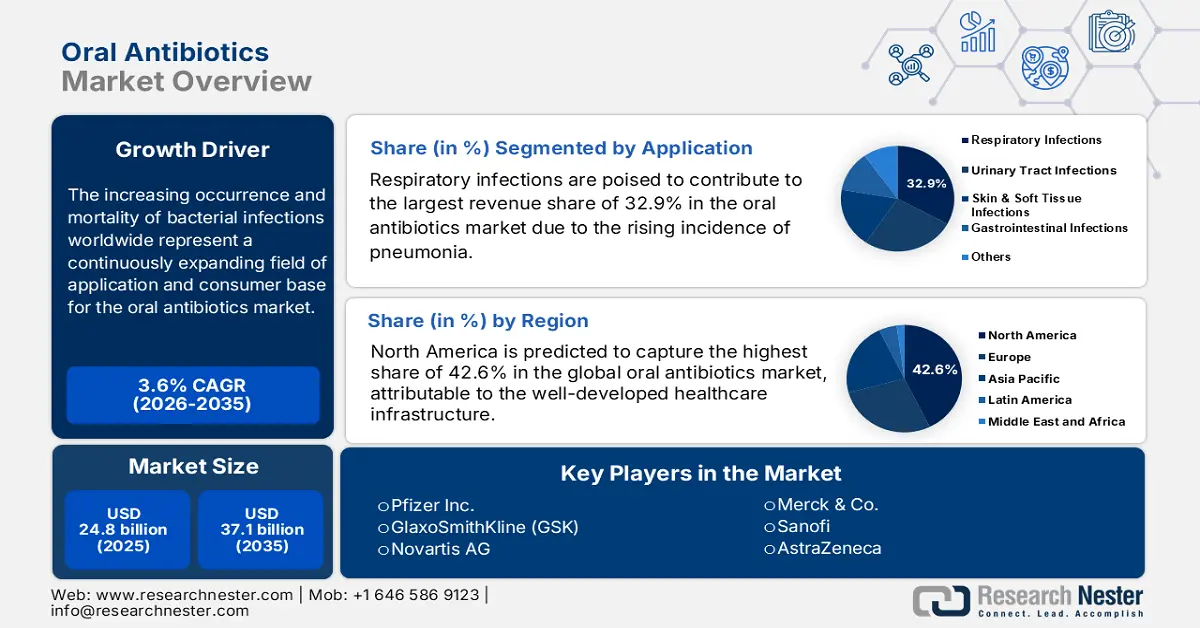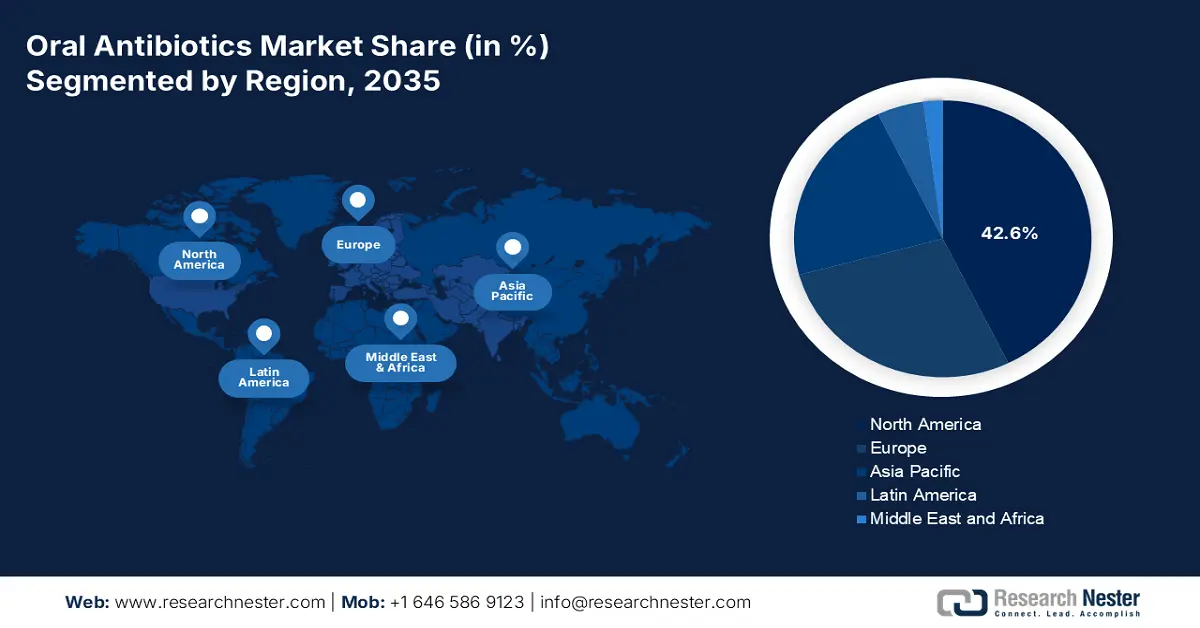Oral Antibiotics Market Outlook:
Oral Antibiotics Market size was over USD 24.8 billion in 2025 and is estimated to reach USD 37.1 billion by the end of 2035, expanding at a CAGR of 3.6% during the forecast timeline, i.e., 2026-2035. In 2026, the industry size of oral antibiotics is estimated at USD 25.2 billion.
The increasing occurrence and mortality of bacterial infections worldwide represent a continuously expanding field of application and consumer base for the oral antibiotics market. Besides, the notable impact of the underlying demographic and clinical conditions, including aging populations and antimicrobial resistance (AMR), is amplifying the volume of the patient pool in this sector. Tetifying to the same, in July 2022, a study was published in support of the NTNU Norwegian University of Science and Technology, demonstrating a sharp spike in the rate of prevalence for urinary tract infections (UTIs) with age. It underscored the incidence rate of UTI to rise from 90 per 100.0 thousand among patients aged 30 to 2473 after the age of 80.

Source: 2022 NLM Article
Similarly, the 2024 findings from the Journal of Medicine, Surgery, and Public Health revealed that the world is expected to witness an escalation of AMR-linked deaths, surpassing an annual 10 million by 2050 in the absence of adequate preventive and treatment measures. These epidemiological trends are creating a surge in demand for advanced formulations, fueling the scope of future expansion in the oral antibiotics market. Besides, the financial exhaustion due to cost inflation in injectables remains a persistent driver in the adoption of oral drugs. Exemplifying the same, in a 2024 article, the Consumer Expenditure Surveys and the Social Consumption of Health Survey showed that the share of injectable antibiotics in nationwide spending in India was 28.4% lower than that of oral due to higher defined daily dose (DDD) pricing.

Oral Antibiotics Market - Growth Drivers and Challenges
Growth Drivers
-
Efforts to improve access to healthcare: The escalated pace of infrastructural development, particularly in emerging economies, is amplifying cash inflow in the market. Governments and international organizations are playing a crucial role in this process by investing heavily in enabling broader access to essential solutions for bacterial infections. Extending health insurance coverage and generic drug affordability are also evidence of such efforts. For instance, from 2021 to 2022, the Ayushman Bharat scheme expanded antibiotic access to patients from rural areas by establishing 150.0 thousand new Health and Wellness Centres across India, as per the Ministry of Health and Family Welfare (MoHFW).
-
Administrative convenience and consumer preference: The market benefits from a strong patient and physician preference for non-invasive, convenient treatment options, particularly in outpatient settings. As this route of administering eliminates the need for rigorous monitoring, it reduces healthcare costs and improves treatment adherence. Thus, this advantage is globally recognized for pediatric, elderly, and chronic infection patients, where ease of use inflates prescription rates. According to an evaluation by the Clinical Microbiology and Infection article, published in September 2023, early switch to oral therapy from intravenous antibiotics for native joint septic arthritis treatment can deliver an overall 98% rate of cure within 2 or 4 weeks.
-
Ongoing innovations in formulations: Sustained R&D investments from both public and private entities are securing future progress in the existing pipelines of the market, with reduced side effects and enhanced resistance profiles. For instance, in November 2024, a team of researchers in India created a novel oral macrolide antibiotic, Nafithromycin (Miqnaf), for treating resistant community-acquired bacterial pneumonia (CABP). This groundbreaking medicine is 10 times more effective than current treatments. Hence, the cohort of innovation in this sector is earning higher consumer trust and greater capital influx.
Historical Patient Pool Growth and Its Impact on the Oral Antibiotics Market
Oral Antibiotic Prescription Rates (2000-2020)
|
Period |
Prescription Rate & Change |
Notes |
|
2011-2016 |
Decreased ~5% from 877 to 836 prescriptions per 1,000 persons |
Decline driven mainly by children (-13%); adults saw a +2% increase; broad-to-narrow spectrum ratio dropped from 1.62 to 1.49 |
|
2020 (Apr-May vs. 2019) |
Significant decrease |
Due to COVID-19 factors: reduced healthcare visits, social distancing, and lower infection transmission rates |
Source: NLM and CDC
Recent Trends and Dynamics of Clinical Trials in the Market
Recent Launches and Clinical Trials
|
Company Name |
Drug Name |
Status |
Year |
|
Acurx Pharmaceuticals, Inc. |
ibezapolstat (IBZ) |
Phase 2b Clinical Trial Data |
2025 |
|
Innoviva, Specialty Therapeutics, Inc. |
zoliflodacin |
Phase 3 trial |
2024 |
|
GSK plc |
gepotidacin |
phase III EAGLE-2 and EAGLE-3 trials |
2022 |
|
Iterum Therapeutics plc |
sulopenem etzadroxil+probenecid |
FDA approved for NDA |
2024 |
Source: Press Releases
Challenges
-
Limitations in profit margins: The tendency to offer lower profit margins compared to other therapeutic areas, such as oncology and chronic disease treatments, the volume of participation in the market is often limited. This is largely attributable to their short-term utilization, widespread generic competition, and pricing pressures. As a result, many pharmaceutical companies are less inclined to invest in research and development for new formulations, shrinking the scope of innovation in this sector.
-
Declining use of antibiotics due to AMR: Despite growing the urge for innovation among pioneers, the widespread AMR still acts as a major roadblock in the market. The misuse and overuse of antibiotics, such as taking them without prescriptions or not completing prescribed courses, have led to the development of resistant bacterial strains. This hampers the efficiency of existing pipelines, forcing healthcare authorities to restrict the consumption volume. Hence, future investors often prohibit themselves from engaging capital in this category.
Oral Antibiotics Market Size and Forecast:
| Report Attribute | Details |
|---|---|
|
Base Year |
2025 |
|
Forecast Year |
2026-2035 |
|
CAGR |
3.6% |
|
Base Year Market Size (2025) |
USD 24.8 billion |
|
Forecast Year Market Size (2035) |
USD 37.1 billion |
|
Regional Scope |
|
Oral Antibiotics Market Segmentation:
Application Segment Analysis
Respiratory infections are poised to contribute to the largest revenue share of 32.9% in the market by the end of 2034. This dominance is largely acquired through the rising incidence of pneumonia and other lower respiratory tract infections (LRTIs), particularly among the elderly and immunocompromised populations. This demographic can be displayed by the 2021 Global Burden of Disease report, which recorded 2.1 million deaths from pneumonia worldwide in the same year. It also identified children under 5 and adults over 70 to be the most vulnerable populations, accounting for more than 500.0 thousand and 1 million fatalities, respectively. Further, till 2024, the ailment claimed the lives of over 700.0 thousand children aged under 5 annually.
Drug Class Segment Analysis
Fluoroquinolones are predicted to hold the dominant share of 28.8% in the market over the assessed timeframe. The broad spectrum of application and high efficiency gain against multi-drug-resistant (MDR) bacterial infections are the foundational pillars of the leadership. These medicines are highly preferred for treating complex infections where resistance to other drug classes is a concern, particularly in urinary and respiratory tract infections. Furthermore, being the gold standard for regulatory compliance has strengthened the sub-segment's position, where government-led initiatives are securing steady capital influx for future research and development.
Distribution Channel Segment Analysis
Hospital pharmacies are poised to acquire the leading share of 38.7% in the market throughout the discussed tenure. This is attributed to the heightening prescription volume, particularly in inpatient and emergency settings, where immediate access to antibiotics is critical. Besides, a majority of these facilities comply with strict regulatory and reimbursement criteria, ensuring the increased use of oral formulations after initial intravenous treatment. As evidence, the proportion of hospitals in the U.S. meeting each of the 7 Core Elements of antibiotic stewardship reached 94.9% in 2021, where the share of facilities having compliance with 6 of the 7 Core Elements was 98.1%, as per the CDC. Moreover, the streamlined bulk purchasing trend among hospital pharmacies contributes to consistent distribution.
Our in-depth analysis of the global market includes the following segments:
|
Segment |
Subsegments |
|
Drug Class |
|
|
Application |
|
|
Distribution Channel |
|
|
Age Group |
|
|
Formulation |
|

Vishnu Nair
Head - Global Business DevelopmentCustomize this report to your requirements — connect with our consultant for personalized insights and options.
Oral Antibiotics Market - Regional Analysis
North America Market Insights
North America is predicted to capture the highest share of 42.6% in the global market during the discussed timeline. This proprietorship is accomplished through the region’s well-developed healthcare infrastructure, high incidence of bacterial infections, and substantial public healthcare spending. The presence of a strong R&D directed capital influx, aimed at combating widespread AMR, is also a major growth factor in this landscape. The surge in this aspect can be validated by the 20% collective increase in the 6 bacterial antimicrobial-resistant hospital-onset infections in the U.S. from 2021 to 2022, as unveiled by the 2024 CDC report.
According to the U.S. Department of Health and Human Services, approximately 1 in every 31 hospitalized patients suffers from at least 1 HAI at any given time, with more than 680.0 thousand infections related to HAIs occurring across the country every year. This testifies to the sustainable demand base present nationwide, fostering a favorable business environment for the market. Besides, the growing burden of AMR is notably enlarging the patient pool, which is creating opportunities for both innovations and widespread adoption in this sector.
Canada is also fueling the regional market with access improvement and greater cash inflow by leveraging federal allocations and policy reforms. As per the 2025 report from the Government of Canada, retail pharmacies across the nation distributed more than 24.4 million antimicrobial prescriptions in 2024 alone. Besides, 71% of this volume of consumption falls under the AWaRe Access antibiotics category, surpassing recommended benchmarks. This signifies the positive impact of the country's success in the responsible and controlled use of these medicines.
APAC Market Insights
Asia Pacific is expected to become the fastest-growing region in the global market by the end of 2035. The remarkable increase in antimicrobial consumption and the enlarging patient population are the propellers of the region's progress in this sector. Testifying to the same, the survey conducted by St. George’s University of London revealed that the rate of human antibiotic consumption in Vietnam and Thailand witnessed significant increases of 111.2% and 122.8%, respectively, from 2016 to 2023. Besides, the growing behavior of self-medication among people suffering from bacterial infection, coupled with the easy availability of these medicines as over-the-counter (OTC) products, is also making APAC the epicenter of high-volume utilization in this category.
China is cultivating a strong emphasis on the regional market, as both a large consumer base and a manufacturing hub. The notable expansion in the user volume across the country is primarily attributable to the rapid centralization of the healthcare system. This demography can be displayed through the 3.5 million patient population of Class A and B infectious diseases in China, as per the 2023 records collected by the NLM. It also reported more than 25.5 thousand deaths due to these ailments in the same year.
India is one of the emerging landscapes in the Asia Pacific oral antibiotics market, which is primarily backed by recent government efforts toward improving rural healthcare access. The country's large population also benefits the sector with a sustainable consumer base. Besides, public allocations for biopharmaceutical advances are creating lucrative opportunities for both domestic and foreign innovation in this sector. Such an influx of capital can be exemplified by the ₹8 crore funding towards the development of a novel oral antibiotic, Nafithromycin, sanctioned by the Biotechnology Industry Research Assistance Council (BIRAC).
Country-wise Import-Export Data for Antibiotics (2023)
|
Country |
Import Value |
Export Value |
|
China |
$656 million |
$4.3 billion |
|
India |
$1.9 billion |
$944 million |
|
Malaysia |
MYR190 million |
MYR37.2 million |
Source: OEC Database
Europe Market Insights
Europe is poised to remain the second-largest shareholder in the oral antibiotics market during the tenure between 2026 and 2035. As the region's growing burden of bacterial infection became a critical public health concern, the demand in this category rose. Testifying to the same, a 2025 NLM study revealed that the consumption of broad-spectrum antibiotics in Switzerland alone increased by 12.3% overall and 17.3% in ICUs during the pandemic. Besides, the population and rising AMR cases pushed the governing bodies to enact adequate measures to allocate sufficient resources, including medicines, in primary healthcare settings, in order to prevent the widespread epidemic. Additionally, the region is seeking to reduce its reliance on Asian producers through proposed legislation, strengthening local production and supply resilience.
Germany is predicted to lead the regional oral antibiotics market with remarkable success in stewardship and increasing bacterial infections among children and adolescents. With a stable prescribing density and a modest increase in penicillin use, the country reflects persistence in maintaining its leadership in this landscape. As evidence, in 2025, the NLM unveiled that the overall penicillin usage in hospitals across Germany increased by 63% for the period from 2012/13 through to 2021/22. It also mentioned that antibiotic consumption volume in intensive care units was approximately twice as high as in normal wards.
According to a survey conducted by the government of the UK, a continuous rise in AMR cases was observed across the country from 2019 to 2023, accounting for an estimated 66.7 thousand serious incidences. This displays the enlarging population of patients with specific needs, and hence, fueling a surge in rigorous R&D in the oral antibiotics market. Providing an overview of this landscape, another report from the governing authorities revealed that, in 2023, antibiotic use in primary care settings accounted for 79.7% of the total nationwide consumption, where penicillins represented the most used antimicrobials.
Export-Import Data for Antibiotics nes, Formulated, in Bulk (2023)
|
Country |
Export Value |
Import Value |
|
France |
$10.6 million |
$3.3 million |
|
New Zealand |
$1.1 million |
$647 thousand |
|
Russia |
$385 thousand |
$16.8 million |
Source: OEC Database

Key Oral Antibiotics Market Players:
- Company Overview
- Business Strategy
- Key Product Offerings
- Financial Performance
- Key Performance Indicators
- Risk Analysis
- Recent Development
- Regional Presence
- SWOT Analysis
The oral antibiotics market is characterized by a dynamic and competitive environment shaped by a dual structure of branded and generic players. Established pharmaceutical giants augment the sector with robust R&D, strong distribution networks, and brand recognition. Whereas the generic pioneers are gaining traction by leveraging their portfolio in cost-effectiveness and regulatory adherence. Moreover, the strategic initiatives, such as acquisitions, collaborations, and new product launches, to overcome hurdles are constructing a progressive atmosphere in this field.
Such key players are:
|
Company Name |
Country |
Market Share (2024) |
Industry Focus |
|
Pfizer Inc. |
U.S. |
18.7% |
Novel antibiotics (Sulbactam-Durlobactam), AMR-focused R&D |
|
GlaxoSmithKline (GSK) |
UK |
15.4% |
Pediatric formulations (gepotidacin), UTI treatments |
|
Novartis AG |
Switzerland |
12.3% |
Broad-spectrum generics, API production |
|
Merck & Co. |
U.S. |
10.5% |
Patented AMR drugs (ceftolozane-tazobactam) |
|
Sanofi |
France |
8.4% |
Combating resistance (cefixime), emerging markets |
|
AstraZeneca |
UK |
xx% |
Respiratory infection antibiotics, global partnerships |
|
Teva Pharmaceuticals |
Israel |
xx% |
High-volume generics, cost-leadership in LMICs |
|
Sun Pharmaceutical |
India |
xx% |
Affordable generics, API integration |
|
Cipla |
India |
xx% |
HIV/TB co-infection antibiotics, Africa-focused |
|
Lupin Limited |
India |
xx% |
First-to-file generics, U.S. market penetration |
|
Dr. Reddy’s Laboratories |
India |
xx% |
Complex generics, EU market expansion |
|
Mylan (Viatris) |
U.S. |
xx% |
OTC-to-Rx transitions, telemedicine partnerships |
|
Bayer AG |
Germany |
xx% |
Veterinary-human antibiotic crossover |
|
Roche |
Switzerland |
xx% |
Diagnostics-driven antibiotic prescriptions |
|
Hikma Pharmaceuticals |
UK |
xx% |
MENA regional dominance, injectable-orals |
|
Yuhan Corporation |
South Korea |
xx% |
AMR research, public-private partnerships |
|
CSPC Pharmaceutical |
China |
xx% |
Bulk API supplier, domestic market control |
|
Pharmaniaga |
Malaysia |
xx% |
Government-backed generics, ASEAN distribution |
|
Innoviva, Inc. |
U.S. |
xx% |
Novel antibiotic development targeting drug-resistant infections |
Below are the areas covered for each company in the oral antibiotics market:
Recent Developments
- In March 2025, GSK attained approval from the FDA for its Blujepa (gepotidacin) for the treatment of UTIs among female adults (≥40 kg) and paediatric patients (≥12 years, ≥40 kg). The accomplishment was gained based on the promising results from the phase III EAGLE-2 and EAGLE-3 trials.
- In February 2025, Innoviva gained acceptance of a New Drug Application (NDA) from the FDA for its first-in-class oral antibiotic, zoliflodacin, for treating uncomplicated gonorrhoea. The drug was designed to address adults and 12+ aged patients, even those who are suffering from infections caused by drug-resistant strains.
- Report ID: 8004
- Published Date: Aug 14, 2025
- Report Format: PDF, PPT
- Get detailed insights on specific segments/region
- Inquire about report customization for your industry
- Learn about our special pricing for startups
- Request a demo of the report’s key findings
- Understand the report’s forecasting methodology
- Inquire about post-purchase support and updates
- Ask About Company-Level Intelligence Additions
Have specific data needs or budget constraints?
Frequently Asked Questions (FAQ)
Oral Antibiotics Market Report Scope
FREE Sample Copy includes market overview, growth trends, statistical charts & tables, forecast estimates, and much more.
Connect with our Expert
 Inquiry Before Buying
Inquiry Before Buying

